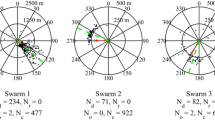Abstract
This study addresses a question that lies at the heart of understanding how the scouts in a honey bee swarm achieve unanimity in their dances, and so reach agreement in their choice of a future nest site: what causes the scouts that perform dances for the non-chosen sites to stop dancing for these sites? One possibility is that a scout stops dancing for a non-chosen site only after she follows a lively dance for another site, such as the site that is ultimately chosen. This hypothesis is contradicted by the finding that 23 out of 27 scouts (in 6 swarms) that danced initially for a non-chosen site stopped their dancing before they followed a dance for another site. Evidently, a scout that supports initially one of the non-chosen sites is likely to withdraw her support for this site even before she learns about another site. What causes her to do so? Close examination of the behavior of scouts revealed that they reduce the strength of their dancing (waggle runs/return to the swarm) for a given site over consecutive returns to the swarm. On average, the pattern of this reduction in dancing is strikingly linear, which suggests that it arises from an internal, neurophysiological process that automatically drives down a scout's motivation to dance for a site. Other results suggest that scouts from inferior sites start their dancing less strongly, and so cease their dancing more rapidly, than do scouts from superior sites. If so, then during the consensus-building process of the scouts, it is the support (the dancing) for inferior sites that is most likely to die out while it is the support for a superior site that is most likely to prevail.



Similar content being viewed by others
References
Adam B (1987) Beekeeping at Buckfast Abbey. Northern Bee Books, Hebden Bridge
Beering ML (2001) A comparison of the patterns of the dance language behavior in house-hunting and nectar-foraging honey bees (Apis mellifera L.). MSc Thesis, University of California, Riverside
Black D (1986) The theory of committees and elections. Kluwer, Dordrecht
Brams SJ, Conrad BP, Lucas WF, Taylor AD (1994) Social choice and decision making. In: Steen LS (ed) For all practical purposes. Freeman, New York, pp 329–490
Camazine S, Visscher PK, Finley J, Vetter RS (1999) House-hunting by honey bee swarms: collective decisions and individual behaviors. Insectes Soc 46:348–360
Detrain C, Deneubourg J-L, Pasteels JM (1999) Decision-making in foraging by social insects. In: Detrain C, Deneubourg J-L, Pasteels JM (eds) Information processing in social insects. Birkhäuser, Basel, pp 331–354
Farquharson R (1969) Theory of voting. Yale University Press, New Haven
Frisch K von (1967) The dance language and orientation of bees. Harvard University Press, Cambridge
Gilley DC (1998) Identity of nest-site scouts in honey bee swarms. Apidologie 29:229–240
Judd TM (1995) The waggle dance of the honey bee: which bees following a dancer successfully acquire the information? J Insect Behav 8:343–354
Kummer H (1971) Primate societies: group techniques of ecological adaptation. Aldine, Chicago
Lindauer M (1955) Schwarmbienen auf Wohnungssuche. Z Vgl Physiol 37:263–324
Michelsen A, Towne WF, Kirchner WH, Kryger P (1987) The acoustic near field of a dancing honeybee. J Comp Physiol 161:633–643
Mitchell C (1970) Weights of workers and drones. Am Bee J 110:468–469
Nieh JC (1993) The stop signal of honey bees: reconsidering its message. Behav Ecol Sociobiol 33:51–56
Oettingen-Spielberg T zu (1949) Über das Wesen der Suchbiene. Z Vgl Physiol 31:454–489
Prins HHT (1996) Ecology and behaviour of the African buffalo: social inequality and decision making. Chapman & Hall, London
Rohrseitz K, Tautz J (1999) Honey bee dance communication: waggle run direction coded in antennal contacts? J Comp Physiol A 184:463–470
Seeley TD (1994) Honey bee foragers as sensory units of their colonies. Behav Ecol Sociobiol 34:51–62
Seeley TD, Buhrman SC (1999) Group decision making in swarms of honey bees. Behav Ecol Sociobiol 45:19–31
Seeley TD, Buhrman SC (2001) Nest-site selection in honey bees: how well do swarms implement the "best-of-N" decision rule? Behav Ecol Sociobiol 49:416–427
Seeley TD, Tautz J (2001) Worker piping in honey bee swarms and its role in preparing for liftoff. J Comp Physiol A 187:667–676
Sokal RR, Rohlf FJ (1981) Biometry, 2nd edn. Freeman, San Francisco
Visscher PK, Camazine S (1999) The mystery of swarming honeybees: from individual behaviors to collective decisions. In: Detrain C, Deneubourg J-L, Pasteels JM (eds) Information processing in social insects. Birkhäuser, Basel, pp 355–378
Weidenmüller A, Seeley TD (1999) Imprecision in waggle dances of the honeybee (Apis mellifera) for nearby food sources: error or adaptation? Behav Ecol Sociobiol 46:190–199
Winston ML (1987) The biology of the honey bee. Harvard University Press, Cambridge
Witherell PC (1985) A review of the scientific literature relating to honey bee bait hives and swarm attractants. Am Bee J 125:823–829
Acknowledgements
I am deeply grateful to my wife, Robin Hadlock Seeley, for minding our kids while I was minding my bees, to Margaret C. Nelson for preparing the complex figures, and to Koos Biesmeijer and Kirk Visscher for providing thorough and thoughtful reviews of the manuscript.
Author information
Authors and Affiliations
Corresponding author
Additional information
Communicated by R. Page
Rights and permissions
About this article
Cite this article
Seeley, T.D. Consensus building during nest-site selection in honey bee swarms: the expiration of dissent. Behav Ecol Sociobiol 53, 417–424 (2003). https://doi.org/10.1007/s00265-003-0598-z
Received:
Revised:
Accepted:
Published:
Issue Date:
DOI: https://doi.org/10.1007/s00265-003-0598-z




